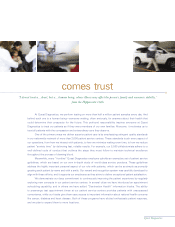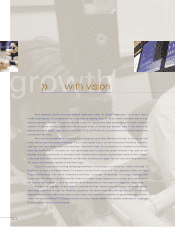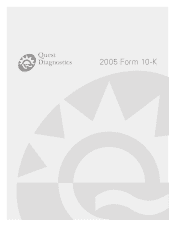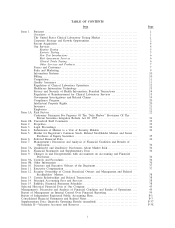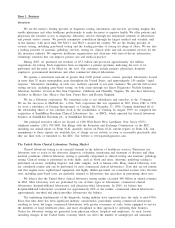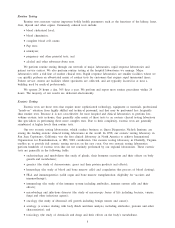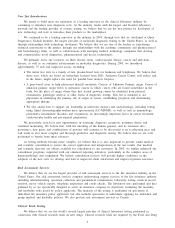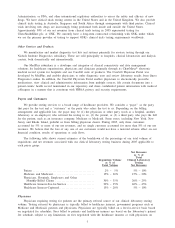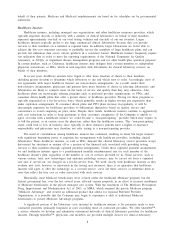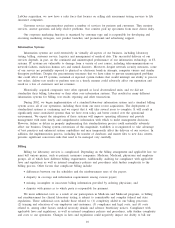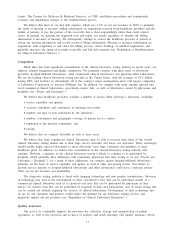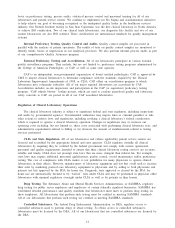Quest Diagnostics 2005 Annual Report Download - page 19
Download and view the complete annual report
Please find page 19 of the 2005 Quest Diagnostics annual report below. You can navigate through the pages in the report by either clicking on the pages listed below, or by using the keyword search tool below to find specific information within the annual report.and design changes in healthcare plans which impact the number of physician office and hospital visits, can
impact the utilization of laboratory testing.
While the diagnostic testing industry in the United States may be impacted by a number of factors, we
believe it will continue to grow over the long term as a result of the following:
•the growing and aging population;
•continuing research and development in the area of genomics (the study of DNA, genes and
chromosomes) and proteomics (the analysis of individual proteins and collections of proteins), which is
expected to yield new, more sophisticated and specialized diagnostic tests;
•increasing recognition by consumers and payers of the value of laboratory testing as a means to improve
health and reduce the overall cost of healthcare through early detection and prevention; and
•increasing affordability of, and access to, tests due to advances in technology and cost efficiencies.
Corporate Strategy and Growth Opportunities
Our mission is to be the undisputed world leader in diagnostic testing, information and services. We focus
on Patients, Growth and People to help achieve our goals.
Patients are at the center of everything we do. Increasingly, patients and their doctors have a choice when
it comes to selecting a healthcare provider, and we strive to give them new and compelling reasons to put their
trust in us. We differentiate our Company to patients and doctors by:
•Providing the Highest Quality Services: We strive to provide the highest quality in all that we do
including: phlebotomy and specimen transport services; analytical testing processes in our laboratories;
providing accurate and timely lab reports; and billing information. We use Six Sigma processes to
continuously reduce defects and enhance quality, and we are utilizing Lean Six Sigma principles to
further increase the efficiency of our operations. Six Sigma is a management approach that utilizes a
thorough understanding of customer needs and requirements, root cause analysis, process improvements
and rigorous tracking and measuring to enhance quality. Lean Six Sigma streamlines processes and
eliminates waste. We also use Six Sigma and Lean principles to help to standardize operations and
processes across the Company and adopt identified Company best practices.
•Offering Unparalleled Access and Distribution: We offer the broadest test menu and national access to
testing services, with facilities in substantially all of the major metropolitan areas in the United States.
We operate a nationwide network of greater than 2,000 patient service centers, principal laboratories
located in more than 35 major metropolitan areas throughout the United States and about 150 smaller
“rapid response’’ laboratories that enable us to serve patients, physicians, hospitals, employers and other
healthcare providers throughout the United States. We believe that customers will increasingly seek to
utilize laboratory-testing providers that offer a comprehensive range of tests and services and the most
convenient access to those services.
Growth is driven organically and through acquisition. We expect to grow organically at or above the
industry growth rate by gaining more customers and selling more to existing customers. Historically, our
industry has focused primarily on service levels and aggressive pricing to drive organic volume growth. We
believe that the differentiation we are creating through our focus on Six Sigma quality, unparalleled access and
distribution, the most comprehensive test menu and innovative test and information technology offerings will
provide us with a competitive advantage and enable us to maintain pricing discipline as we drive profitable
organic growth. Additionally, we are investing in sales and marketing, providing the sales force with better tools
and training and adding innovative new products to sell. We are specifically focused on driving profitable
organic growth in higher-growth areas by being a leading innovator. Our principal areas of focus include:
•Physician Sub Specialties: While we provide a strong value proposition in routine and esoteric clinical
testing, we have not been the provider of choice for certain pathology testing needs. We are enhancing
our test menu and service capabilities to more effectively compete in several physician sub specialties,
including urology, gastroenterology, dermatology and oncology, where we have had a smaller market
share.
•Anatomic Pathology: Of the total United States clinical laboratory testing market, which we believe
exceeded $40 billion in annual revenues in 2005, we estimate that the current United States market for
2


